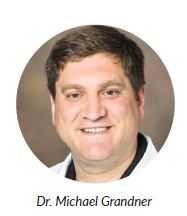For decades, researchers have reported and recorded differences in sleep for women and men, with more recent studies including transgender and nonbinary individuals. Dr. Michael Grandner of the University of Arizona has been working in the field of sleep medicine and research for about 20 years. He states, “After adjusting for demographics, socioeconomics, health variables, and depression, the rates of many sleep disturbances are more prevalent among women and people from gender minority groups.”

SLEEP FOR WOMEN
Biological factors are major culprits for sleep disturbances for women. Pregnancy often causes sleep fragmentation, gestational sleep apnea, restless legs, and insomnia. Then, there is the risk of postpartum depression and disturbances caused by breastfeeding and caring for infants. Later, women are likely to experience sleep disturbances due to menopause—a transition often characterized by insomnia, hot flashes and sleep fragmentation. This leads to Dr. Grandner’s summary, “Women for all age groups between 25 and 69 years report a prevalent rate of sleep disturbances. Reports of daytime tiredness are also more common in women aged 18-59. In fact,” Dr. Grander continues, “overall, in the general population, women report shorter sleep duration, more sleep symptoms and greater rates of insomnia.”
SLEEP FOR MEN
Men, too, find sleep is frequently disrupted with an infant in the home. But for men, higher rates of obstructive sleep apnea (OSA) may be a more likely reason for poor sleep quality. Additionally, men are more likely to have difficulty seeking and then adhering to sleep apnea treatment, per Dr. Grandner. “Men are more likely to allow OSA complications to potentially become lethal.” Though it remains unclear if it is simply due to more men reporting the issue, men are slightly more likely to be diagnosed with REM behavior disorder, a disorder that causes a person to physically act out dreams, often with violent arm and leg movements during REM sleep. REM behavior disorder has been linked as a precursor to future neurodegenerative disorders.
SLEEP FOR FOR SEXUAL AND GENDER MINORITIES
Several studies suggest that sleep health among LGBT individuals may be an unmet health need. LGBT health research suggests that minority stress contributes to sleep disparities, showing sexual minorities have a higher prevalence of sleep deprivation compared with straight counterparts, though the sleep deprivation varies by sexual identity and gender. One study examined sleep quality and associated factors among transgender and gender nonbinary (TGNB) individuals. Of the group, participants suggested that mental health issues and gender identity were most likely to cause difficulty falling asleep. Additionally, research has led to interesting questions regarding obstructive sleep apnea (OSA). When studying the effects of transgender hormone therapy, researchers noted that some transgender males (assigned female at birth) developed OSA following initiation of male sex hormones.
THE BRIGHT SIDE
Though some of these outcomes may sound discouraging, the key takeaway should be that all of these sleep disturbances are treatable. A person does not have to accept the outcome and live without healthy sleep. There will always be seasons of life, such as that with an infant, where there are few ways around the lack of sleep. But for those living with insomnia, there is Cognitive Behavioral Therapy for Insomnia (CBT-I). For menopausal sleep disturbances or REM behavior disorder, there are behavioral and pharmaceutical treatments, and for sleep apnea, there are a myriad of treatments ranging from facial exercises to apnea masks to surgery.
Dr. Grandner finishes by adding, “Sleep in most humans represents a universal biological need, which occupies up to a third of the day. Improving sleep has an impact on general health, cardiovascular health, metabolic health, mental health, immunologic health, human performance, cancer, pain and mortality. My hope is that by knowing what our sleep disturbances are and how to treat them, we can all become healthier.”



